Louisiana has many diverse habitats that host different types of dazzling birds. More than 470 species of birds live in Louisiana. Among these species are more than ten types of hawks commonly sighted within the state.
Louisiana boasts numerous productive national wildlife refuges, wetlands, barrier islands, and pinewoods that birds call home. It encompasses enough diversity to make it one of the most rewarding birding destinations in the United States.
Here are 10 types of hawks you are most likely to come across in Louisiana.
1. Broad-winged Hawk
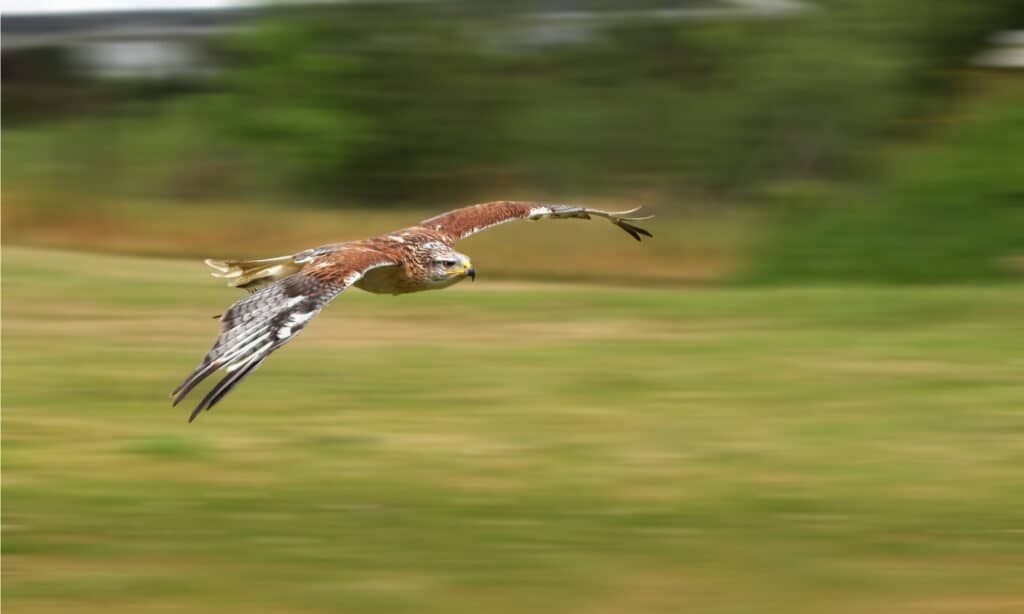
Broad-winged hawks build their nests in mixed coniferous-deciduous or pure deciduous forests.
©pr2is/Shutterstock.com
| Broad-winged Hawk | |
|---|---|
| Scientific name | Buteo platypterus |
| Weight | 2-4 pounds |
| Height | 34-44 cm |
| Wingspan | 35 inches |
Broad-winged hawks are medium-sized raptors that reside in Louisiana year-round. They derive their name from the distinctive broad and slightly pointed wings. They have reddish-brown heads and are barred underneath with white-and-black banded tails. Fall is the best time to watch these fascinating species when they are migrating in groups of thousands.
Broad-winged hawks inhabit the groves and woods. They build their nests in mixed coniferous-deciduous or pure deciduous forests, often near clearings, edges, or water bodies. Females lay between 2 and 3 eggs per breeding season. The incubation period lasts for 28-31 days.
These hawks have a diet that consists of squirrels, voles, mice, toads, lizards, snakes, frogs, young turtles, large insects, and numerous small birds. They often hunt by watching for prey from a raised perch or may opt to fly along watercourses or through the woods, actively searching for any available prey.
2. Red-shouldered Hawk
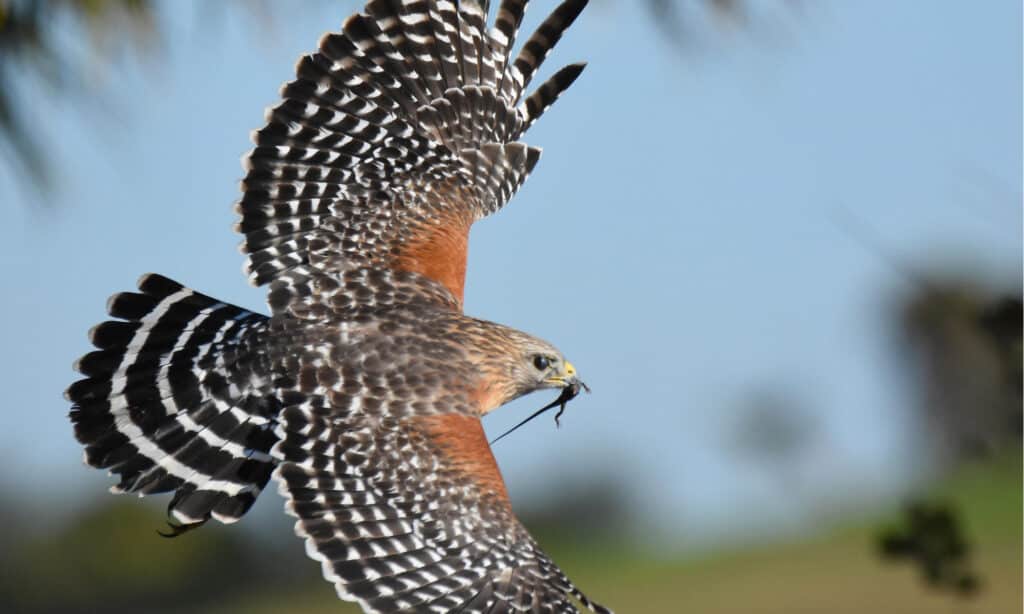
Red-shouldered hawks have black-and-white checkered wings with black-and-white banded tails.
©MTKhaled mahmud/Shutterstock.com
| Red-shouldered Hawk | |
|---|---|
| Scientific name | Buteo lineatus |
| Weight | 1.5 pounds |
| Height | 43-61 cm |
| Wingspan | 90-127 cm |
Red-shouldered hawks are unique medium-sized raptors found in Louisiana throughout the year. They are named after the red-colored barring on their breasts. They have black-and-white checkered wings with black-and-white banded tails.
Red-shouldered hawks inhabit the swampy areas, bottomland woods, and deciduous forests. They prefer nesting in deciduous or mixed forests with tall trees and an open understory, often along swamps and rivers. Females lay between 3-4 pale bluish-white eggs spotted with lavender and brown. The eggs take roughly 33 days to hatch.
Their diet consists of small birds, mice, chipmunks, voles, toads, frogs, snakes, and other small mammals. They usually prefer to take prey by surprise, so they hunt by watching for them from a perch. Upon locating a prey, they swoop down rapidly to capture it using their sharp talons.
3. Red-tailed Hawk
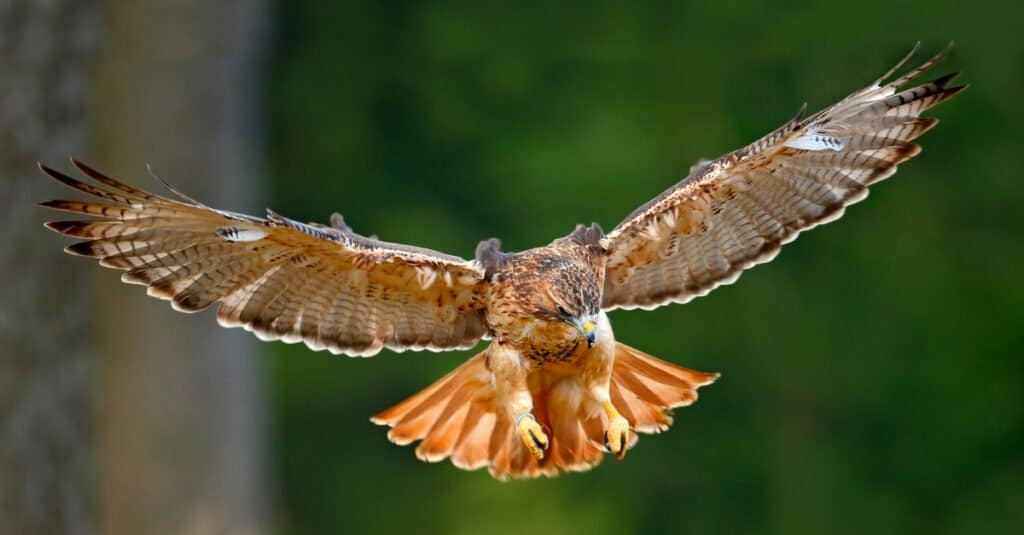
Red-tailed hawks inhabit the plains, mountains, prairie groves, and woodlands.
©Ondrej Prosicky/Shutterstock.com
| Red-tailed Hawk | |
|---|---|
| Scientific name | Buteo jamaicensis |
| Weight | 2.75 pounds |
| Height | 17-25 inches |
| Wingspan | 45 to 56 inches |
Red-tailed hawks are the most common and largest birds of prey in Louisiana. They derive their name from their red tails, though juveniles don’t have red tails. Immature red-tailed hawks have brown and banded tails. Most adult hawks have pale underparts with streaked bellies.
Red-tailed hawks can be found in any kind of terrain. They inhabit the plains, mountains, prairie groves, and woodlands. They are frequently seen along roadsides. Nest sites also vary. They nest on trees, cliff ledges, on artificial structures, or among the arms of giant cacti. Females lay 2-3 eggs per breeding season. The eggs hatch in about 28-35 days.
These hawks mainly feed on small birds, mice, rats, voles, rabbits, ground squirrels, snakes, insects, frogs, and many other small mammals. They hunt by watching for prey from a raised perch. They also fly over fields in search of prey.
4. Swainson’s Hawk
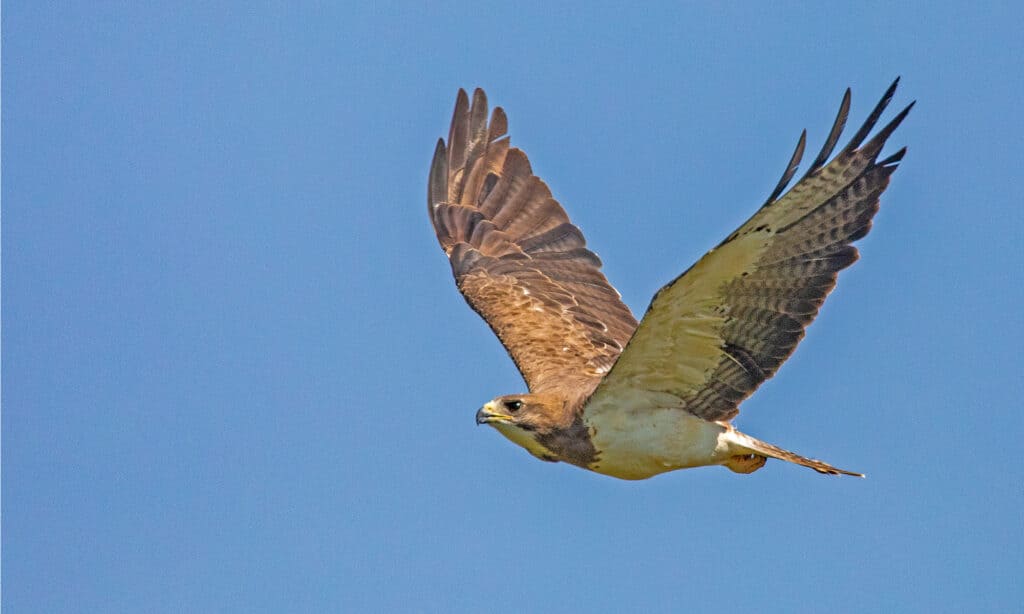
Swainson’s hawks spend most of their time on tall trees, utility poles, and fence posts.
©Lowell Monke/Shutterstock.com
| Swainson’s Hawk | |
|---|---|
| Scientific name | Buteo swainsoni |
| Weight | 1.5-3 pounds |
| Height | 43-56 cm |
| Wingspan | 117-137 cm |
Swainson’s hawks are slim, broad-winged hawks that are often sighted in large parts of Louisiana all year. They are dark brown above with a whitish underneath. They can be found in farmlands, dry grasslands, and plains. They spend most of their time on tall trees, utility poles, and fence posts.
In early summer, Swainson’s hawks usually feed on reptiles and other small mammals. They eat large insects like the nomadic dragonflies in different seasons. They soar over grasslands or perch from one place to another in search of prey. Also, they run about on the ground while trying to catch insects in the open fields.
Nesting sites are usually on top of trees with scattered groves. They may also nest on steep slopes of cliff ledges. They renovate the old nests of other large birds. Females lay between 2-3 pale bluish-white eggs that take about 34-35 days to hatch.
5. Ferruginous Hawk
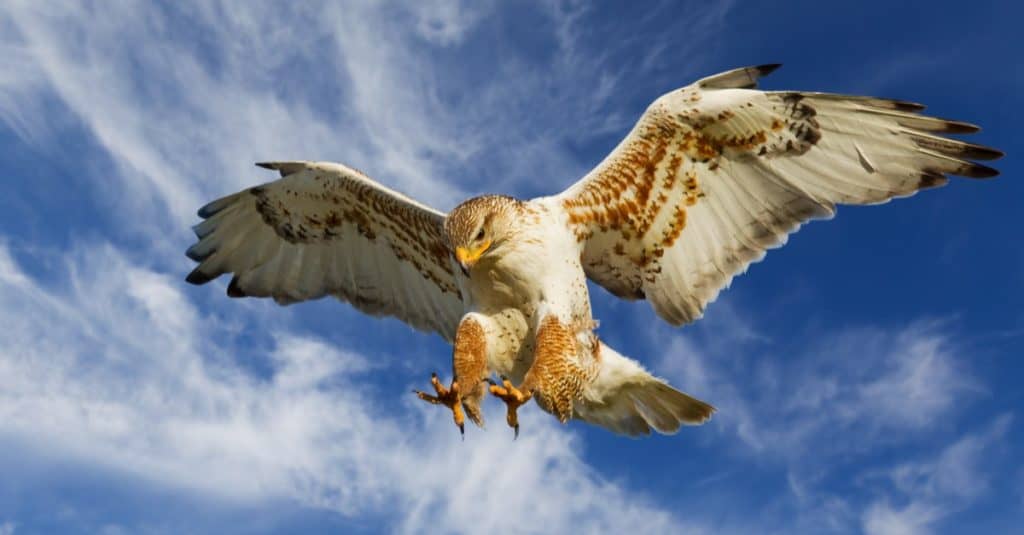
Ferruginous hawks are large birds of prey usually found in southwestern Louisiana.
©Stephen Mcsweeny/Shutterstock.com
| Ferruginous Hawk | |
|---|---|
| Scientific name | Buteo regalis |
| Weight | 2.2 and 5 pounds |
| Height | 51-69 cm |
| Wingspan | 122-152 cm |
Ferruginous hawks are large birds of prey usually found in southwestern Louisiana. They have broad wings and large white heads. They are reddish on the top and also on their feathered legs. These raptors inhabit the prairies and plains. They are always spotted at the edges of the forests, near shrublands, and grasslands throughout Louisiana.
They feed primarily on small to medium-sized mammals. They eat readily available prey like mice, cottontails, kangaroo rats, pocket gophers, ground squirrels, and young jackrabbits. They watch for prey either from a raised perch or may soar at a considerable height to catch sight of prey.
The nest site is usually on top of a tree, on the ground, or on a cliff. They reuse their nests for more than one season. Females lay between 2 and 4 pale eggs per breeding season. The incubation period lasts for about 32-33 days.
6. Sharp-shinned Hawk
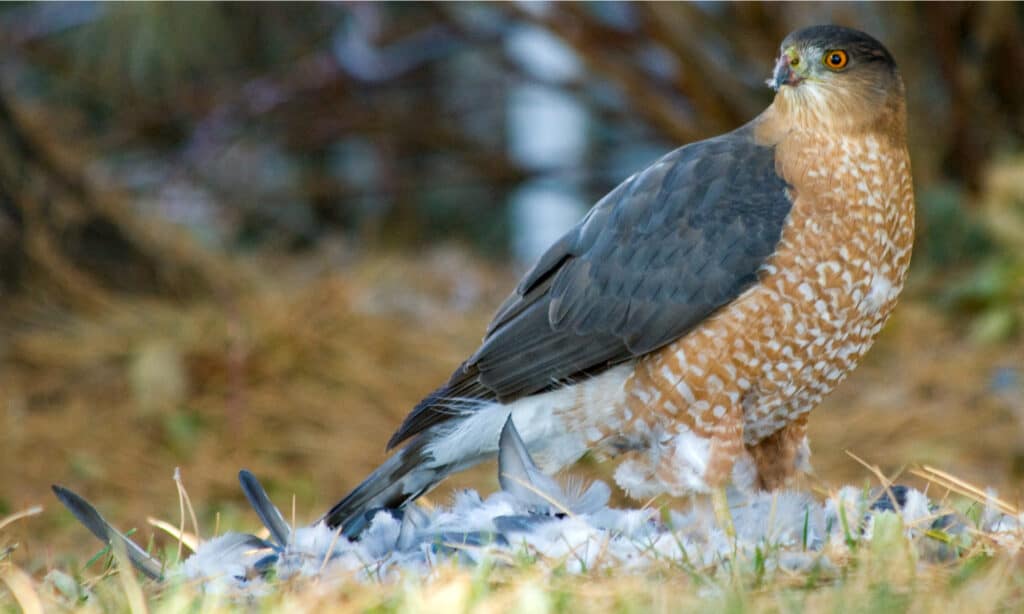
Sharp-shinned hawks live in open deciduous woodlands or coniferous forests.
©Wyatt W/Shutterstock.com
| Sharp-shinned Hawk | |
|---|---|
| Scientific name | Accipiter striatus |
| Weight | Less than 1 pound |
| Height | 24-34 cm |
| Wingspan | 42-58 cm |
Sharp-shinned hawks are the smallest accipiters. They are commonly seen in Louisiana, mainly due to yearly migration from Canada. They have distinctive pale gray feathers with rust-colored underneath. They are best known for their long tails, round wings, long legs, and a high-pitched scream.
Sharp-shinned hawks live in open deciduous woodlands or coniferous forests. They prefer to lurk in the woods as they ambush songbirds and other small birds. They hunt mostly by approaching the unsuspecting prey stealthily through dense cover.
These raptors conceal their nests in dense conifers within the forest or thick grove. Females lay between 4-5 bluish-white eggs that are spotted with brown. The incubation period lasts for about 30-35 days.
7. Cooper’s Hawk

Cooper’s hawks feed on medium-sized birds, mice, ground squirrels, chipmunks, reptiles, and insects.
©Richard G Smith/Shutterstock.com
| Cooper’s Hawk | |
|---|---|
| Scientific name | Accipiter cooperii |
| Weight | 1-2 pounds |
| Height | 7-27 cm |
| Wingspan | 62-90 cm |
Cooper’s hawks are small to medium-sized birds of prey commonly found all year in Louisiana. They are pale, bluish-gray on top and orange underneath. Their wings are short and thin, with rounded tails. Females are larger than males.
Cooper’s hawks inhabit open woodlands, forests, river groves, and wood edges. They build their nests on top of a deciduous or coniferous tree. They may also choose a pre-existing foundation as their nest. They only make a few modifications. Females lay 3-5 pale bluish-white eggs that hatch in about 34-36 days.
These hawks feed on medium-sized birds, mice, ground squirrels, chipmunks, reptiles, and insects. They hunt in dense cover by moving from one perch to the other while watching and listening to the sounds of potential prey. They put on a burst of speed to overtake prey once they spot one.
8. Harris’s Hawk
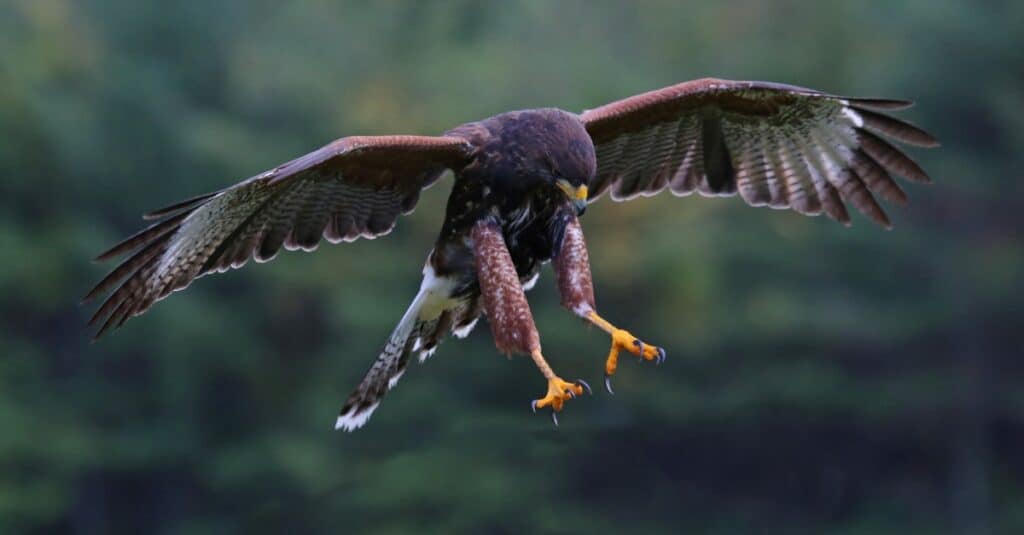
Harris’s hawks are medium-to-large-sized hawks found in the southwestern parts of Louisiana.
©iStock.com/ca2hill
| Harris’s Hawk | |
|---|---|
| Scientific name | Parabuteo unicinctus |
| Weight | 1.5-2.5 pounds |
| Height | 46-59 cm |
| Wingspan | 103-120 cm |
Harris’s hawks are medium-to-large-sized hawks found in the southwestern parts of Louisiana. They have brown-colored feathers with distinct bright-colored shoulders. They also have unique white marks on their tails.
These hawks are commonly sighted in open, dry areas like cactus deserts, brushlands, mesquite, and sometimes river woods. They build their nests on giant saguaro cactus or on top of small trees. The nest may be re-used for several seasons. Females lay between 3-4 eggs per breeding season. Eggs hatch in about 33-36 days.
Harris’s hawks feed on small birds, lizards, kangaroo rats, woodrats, rabbits, ground squirrels, and other small creatures. They hunt actively by pursuing prey around thickets and bushes. They often hunt in groups of two or three, such that any prey that has managed to evade one hawk may be caught by the next.
9. Northern Harrier

Northern harriers inhabit prairies, fields, and marshes.
©Harry Collins Photography/Shutterstock.com
| Northern Harrier | |
|---|---|
| Scientific name | Circus hudsonius |
| Weight | 0.5-1.3 pounds |
| Height | 46-50 cm |
| Wingspan | 102-118 cm |
Northern harriers are medium-sized hawks found throughout Louisiana all year. Adult male hawks are gray on top with dark feathers towards the edge of their wings. Females and immature northern harriers are brown with streaky feathers above and pale-colored underneath.
Northern harriers inhabit prairies, fields, and marshes. They can also live in open areas, both wet and dry habitats. They prefer breeding in the marshes. Females are in charge of building the nests while males supply the construction materials. Females lay between 4-6 pale bluish-whitish eggs that hatch in 30-32 days.
Northern harriers feed on small birds, rats, voles, lizards, small rabbits, and other small mammals. They hunt by hovering over fields, watching for prey movement on the ground. They may also locate prey by sound.
10. Rough-legged Hawk
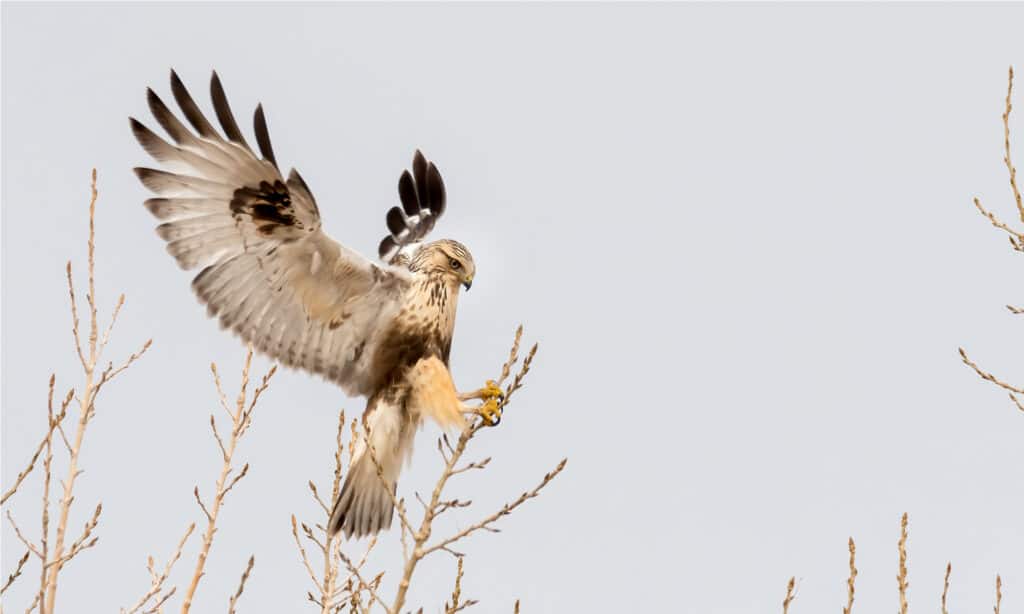
Rough-legged hawks live on farmlands, marshes, coastal prairies, and grasslands in winter.
©Eivor Kuchta/Shutterstock.com
| Rough-legged Hawk | |
|---|---|
| Scientific name | Buteo lagopus |
| Weight | 2.8 pounds |
| Height | 47-52 cm |
| Wingspan | 132-138 cm |
Rough-legged hawks are medium-sized birds of prey commonly sighted throughout Louisiana. They are named after their unique feathered legs. They are often dark brown to black on the top, with white marks on their tails.
Their habitats vary with the seasons. They live on farmlands, marshes, coastal prairies, and grasslands in winter. They are often found around Louisiana airports all year. They breed mostly on the tundra and build their nests on cliffs or ledges. Females lay between 3 and 5 pale bluish-whitish eggs that hatch in about 31 days.
Rough-legged hawks feed on voles, lemmings, ground squirrels, mice, frogs, insects, and small birds. They also eat carrion, especially in winter. They hunt by watching for prey from a perch or flying low over fields, watching for prey movements below.
The photo featured at the top of this post is © Stephen Mcsweeny/Shutterstock.com
Thank you for reading! Have some feedback for us? Contact the AZ Animals editorial team.






